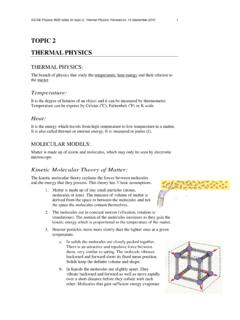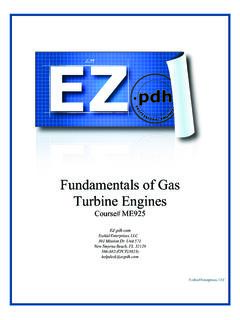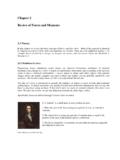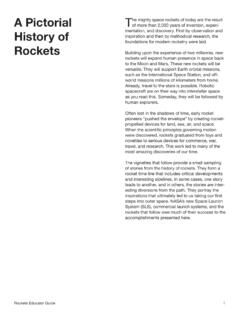Transcription of Topic 1 General Physics - revised
1 IGCSE Physics 0625 notes for Topic 1: General Physics : revised on 14 September 2010 1 Topic 1 General Physics UNITS OF MEASUREMENT: Measurement means comparing any physical quantity with a standard to determine its relationship to standard. This standard is called unit. All measurable quantity expressed in a) some number or magnitude and b) some unit For example if the distance is 200km, 200 is the number or magnitude and km (kilometer) is the unit. Systems of Units: There are three major systems of units. 1. system: meters kilogram second system used internationally. This system is also called SI (system international) units. 2. system: foot pound second system use by British. 3. system: centimetre gram second system use by French.
2 Measurement of physical quantities base units: Length or distance (s): The base unit of length or distance is meter (m). It is define as: The meter is the length of the path travelled by light in vacuum during a time interval of 1/299 792 458 of a second. The measurement of length is used to calculate the: i. thickness of a thin wire using vernier calliper. (The precision of length measurements can be increased by using the devices that use sliding vernier scale.) ii. area of square or rectangle = length and breadth iii. area of triangle = base x height iv. volume of cube = length x breadth x height Prepared by Faisal Jaffer: Emirates Private School, Al Ain 2v. volume of liquid = height in calibrated measuring cylinder Mass (m): It is the measure of the quantity of matter in an object and its unit is kilogram (kg) in SI units.
3 It depends on the number of molecules in the matter and their masses and does not depend on gravity. Therefore an object would have same mass on Earth and on the Moon but different weight because of the change of gravity. Gravity on the moon is 1/6th of the gravity on earth. Mass of an object can be measured by using spring balance ( newton -meter), top pan balance or lever balance. The international definition of mass is It is equal to the mass of the international prototype of the kilogram made up of platinum-iridium alloy kept at international bureau of weights and measurements in Paris. Time (t): It is the ordering or duration of events. The unit of time is second (s) which is defined as: the particular frequency of electromagnetic spectrum given out by the common type of caesium atom.
4 The common devices to measure the time or duration of an event are clock and stopwatch. In stopwatch, each second is calibrated into one hundred part of a second called centisecond. The precession of time duration of an event can be improved by measuring the time for number of events and dividing time by total number of events. For example to measure the time period of a pendulum the time for ten swings should be recorded and dividing the total time by ten to get the time for one swing. SPEED, VELOCITY AND ACCELERATION: Speed: Average speed is defined as the distance covered by an object in unit time. = = The SI unit of speed is meters/second (m/s) and it has no definite direction.
5 IGCSE Physics 0625 notes for Topic 1: General Physics : revised on 14 September 2010 3 Velocity: Velocity is defined as the distance travelled by an object in specific direction in unit time. velocity = Distance moved in specific direction is called displacement therefore the above equation can be written as = v =s t s = the displacement in meters (m) t = total time in seconds (s) v = velocity, the SI unit of velocity is meters/second (m/s) The object is said to be in linear motion if it moves in straight line. Acceleration: Acceleration is the change of velocity of a body in unit time. = or = Where u is the initial velocity and v is the final velocity.
6 The SI unit of acceleration is meters per second square (m/s2). Acceleration is positive if the velocity is increasing and negative if the velocity is decreasing and this is called retardation or deceleration. Graphical representation of velocity, acceleration and distance: Velocity time graphs: The curve line in speed time graph means that the object is moving with non-uniform acceleration. The acceleration at any point is the gradient to the tangent at that point. In velocity-time or speed-time graph the area under the graph is total distance covered by the object. In velocity-time or speed-time graph the gradient of the line is acceleration. Prepared by Faisal Jaffer: Emirates Private School, Al Ain 4 Distance time graph: Terminal Velocity: The terminal velocity of an object falling towards the earth, is the speed at which the downward gravitational force w ( weight) is equal and opposite to the air resistance which is pushing it upwards which means that the there is not net force and therefore no acceleration.
7 At this speed, the object does not accelerate and falls at constant speed. The terminal velocity whose value is depends upon the size, shape, volume and weight of the object. For example, the terminal velocity of a skydiver in a normal free-fall position is at certain point when his weight is equal to air resistance. The reason an object reaches a terminal velocity is that the air resistance is directly proportional to the square of its speed. At low speeds the air resistance is much less than the gravitational force and so the object accelerates. As it speeds up the air resistance increases, until eventually it equals the weight. The diagrams below explain the situation v w=m g Air resistance a IGCSE Physics 0625 notes for Topic 1: General Physics : revised on 14 September 2010 5 MASS, WEIGHT AND DENSITY: Mass: Mass of an object is the measure of the amount of matter in it.
8 The base unit of mass is the kilogram (kg). 1kg =1000g 1 kilogram is the mass of a piece of platinum-iridium alloy at the office of weights and measurements in Paris. Weight: The weight of an object is the force due to earth`s gravity. The nearer an object is to the centre of the earth the more the earth attracts it. Since the earth is not a perfect sphere but flatter at the poles, the weight of a body varies over the Earth s surface. It is greater at the poles than at the equator. The weight of an object of mass m can be found by = Where w is the weight in newtons, m is the mass in kilogram and g is the acceleration due to gravity whose value is or 10 m/s2 for IGCSE course. Density: It is defined as the mass per unit volume of a substance.
9 The unit of density is kg/m3 or g/cm3. It is denoted by Greek symbol (rhoo) and is calculated from the formula: = = Density of regularly shaped solid: The mass can be determined by top-pan balance and the volume by multiplying length, width and height. Density of irregularly shaped solid for rock: The mass of the solid is determined by top-pan balance. The volume of solid is obtained by subtracting the value before and after immersing the rock in a measuring cylinder containing water. This method is called displacement method. Density of liquid: The mass of an empty beaker is found on a balance. A known volume of the liquid is transferred from burette or measuring cylinder into the beaker. The mass of beaker plus liquid is found and the mass of liquid is obtained by subtraction.
10 Density of air: The mass of a 500 cm3 round-bottomed flask full of air is found and then after removing the air with a vacuum pump; the difference gives the mass of air in the flask. The volume of air is found by filling the flask with water and pouring it into a measuring cylinder. Mass on top-pan balance Mass in a measuring cylinder containing water Prepared by Faisal Jaffer: Emirates Private School, Al Ain 6 EFFECTS OF FORCE: EXTENSION / LOAD (FORCE) INVESTIGATION Force is a push and pull of an object. Force can change the direction of the movement and the shape of an object. Force can extend the length of an object. Hooke s Law: Robert Hooke was the first to investigate the extension of the spring nearly 350 years ago. He stated the law of extension of the spring/string when stretching force is applied to it.










